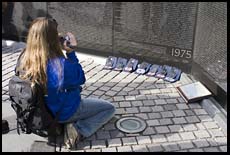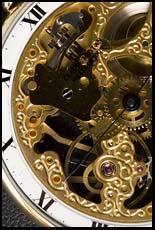
Canon Rebel XTi Review
by Philip Greenspun; created December 2006
Site Home : Photography : Rebel XTi

by Philip Greenspun; created December 2006
Site Home : Photography : Rebel XTi

The Canon Rebel XTi is the world's most popular digital single-lens reflex camera. The Rebel XTi is compact, lightweight, rugged, inexpensive, responsive, and compatible with dozens of the world's best lenses. Introduced in the fall of 2006 at a price of $800, the Canon Rebel XTi has the best image quality of any camera in its class. For family picture-taking, the best way to start is with the Canon Rebel XTi body only and a Sigma 30/1.4 lens (all the photos on this page were taken with this lens); if you must have a zoom, the Canon 17-55/2.8 IS USM is a high quality choice.
At any one time, Canon generally produces three consumer-priced digital single lens reflex bodies:
For most photographers, the right body will be either the Canon Rebel XTi or the Canon EOS 5D. The 30D is an older design with more rugged construction, but very similar imaging capabilities. The Rebel XTi actually has slightly higher resolution and a new sensor dust removal system that the 30D lacks.
The Canon Rebel XTi is a great value and, if coupled with a high quality lens, can produce pictures that will be acceptable for nearly any purpose.
[Outside the United States, this camera may be marketed as the "Canon EOS 400D" or "Kiss Digital X".]

The Canon Rebel XTi turns on almost instantly and is very responsive for taking pictures, displaying previews, and waking up once asleep. The camera is always ready when you are, unless you fill up the in-camera memory by taking photos continuously, as you might at a sporting event. The camera can capture 3 pictures per second but it can't write them to the CompactFlash card that fast. After you've captured about 30 JPEGs or 10 RAW images, the rear LCD will read "BUSY" for a few seconds until all of the images have been saved.
The main difference between the Rebel XTi and the larger more expensive Canon bodies is that there is only one control wheel, on the top of the camera body. In Metered Manual mode, for example, the single wheel adjusts the shutter speed and, if you hold a shift button on the back of the camera, can adjust the lens aperture. In Aperture-priority mode, the single wheel adjusts the aperture and holding the shift button makes the wheel control exposure compensation (to darken or lighten the image). Having to press a shift key is annoying, but if you are mostly capturing RAW images and using semi- or fully automatic exposure, you will hardly ever have to do it.
Almost every digital SLR has an LCD display on the top giving out information on exposure, autofocus, white balance, and other camera settings. There is another, larger LCD screen on the back offering image review and menus for controlling camera settings. You might ask "If you have a huge 2.5" screen on the back of the camera, why not get rid of the little display on the top of the camera?" That's just what Canon has done with the Rebel XTi and it is probably an improvement in user interface. If you want to know how the camera is set up there is one and only one place to look. The information is much larger and more readable than on top-deck LCD displays, especially the ISO setting, which is presented in huge letters at the upper right. A photocell on the back figures out if you've raised the camera to your eye and shuts the screen off.
A top-deck control switch lets you choose among the standard four exposure modes: Metered Manual, Aperture-priority, Shutter-priority, and Program autoexposure. The same switch has "idiot modes" labeled with small icons, such as a running guy. The rear LCD screen shows the same icon and a text explanation, e.g., "sports".
The has the standard focus modes of any Canon SLR: Manual, Single-shot auto, "AI Servo" (continuous, intended for sports), and "AI focus" where the camera tries to figure out whether or not your subject is moving. As with all of the great Canon EOS bodies over the decades, if you drill down into the custom function menus, you can figure out how to make the autoexposure lock button on the back of the camera into a "burst of AF" thumb switch while in Manual Focus mode. Thus you're able to manually adjust focus but have automatic assistance available when desired. (Start at the Tools 2 menu then Custom Function 4.) Autofocus performance is excellent, even in dim light, with 9 AF sensors distributed around the frame.
Operation is modeless. If you've pressed the playback button and are reviewing images, a quick touch of the shutter release readies the camera to take pictures again. Curiously, Canon seems unable to get this important user interface feature into their point and shoot cameras, all of which have a playback/record switch on the back and the camera won't function as a camera if the switch is set to "playback".
Overall, the best user interface of any Canon digital SLR body.

The viewfinder shows a little bit less of the image than the sensor will capture, i.e., your photo will be about 5 percent wider and taller than what you saw in the viewfinder. Underneath the optical through-the-lens view is a one-line in-viewfinder LCD display showing shutter speed, aperture, an exposure meter, focus confirmation (dot that appears when something in the image is in focus), a flash symbol that lights up when the flash is ready, an exposure-lock symbol, and a counter showing how many more photos may be captured before filling up the in-camera memory buffer (only relevant when photographing sports in RAW mode). It is easy to view the entire viewfinder image and the one-line LCD display underneath, even while wearing eyeglasses. If you don't want to wear eyeglasses, the Rebel XTi has a built-in diopter adjustment (-3 to +1).

The Rebel XTi takes a single Compact Flash card, either Type I and II. Microdrives work in the camera, but operate slowly if you are capturing RAW images. Microdrives are also more prone to failure than the solid-state CF cards.
A 1 GB card will hold fewer than 100 RAW images, each of which is typically just over 10 MB in size; remember that the images are 3888x2592 pixels. Start with either a 4 GB CF Card or an 8 GB card
The Canon Rebel XTi has a built-in flash powerful enough (guide number 42 in feet at ISO 100) to serve as a primary light at ISO 400 or ISO 800. Maximum flash sync speed is 1/200th. Balancing flash and natural light requires wading down through a couple of menus to set flash exposure compensation. Once set, however, the exposure compensation is clearly displayed on the rear LCD.
If you're going to photograph a reception in a dark restaurant, slide a 580EX flash into the accessory shoe on top of the camera. Both internal and external flash exposure may be controlled by the camera's computer using a through-the-lens sensor.

The best way to ruin a photo is by using an on-camera flash as the primary light source, which is why photos taken indoors with point-and-shoot digicams are usually so terrible. If you're stepping up from a point-and-shoot and go into a living room with the Rebel XTi and a Sigma 30/1.4 lens, you will feel like a superhero. Thanks to the physically much larger sensor, images at ISO 800 and ISO 1600 are much better than what you'd get with a point-and-shoot. With an f/1.4 lens, you will be able to use the lower noise setting of ISO 400 in many indoor situations.
If you're stepping down from the world's highest performance low-light digital SLR, the full-frame 5D with its substantially larger sensor, you'll be underwhelmed with the Rebel XTi's low-light capability, though autofocus performance is surprisingly good.
[Photo at right: ISO 800, 1/100th at f/2.5]
The included Lith-ion battery is adequate for a day of active photography, somewhere between 300 and 500 photos plus review. The Canon Rebel XTi will not run on disposable AA batteries. To recharge the battery you must carry a chunky travel charger that plugs directly into a wall socket.
If you are a serious photographer, you will want to purchase and carry a backup NB-2LH battery. If you add the BG-E3 vertical grip, the camera will draw its power from two of these Lith-ion batteries inside the grip, or alternatively, six AA batteries. The vertical grip adds a vertical shutter release and may make the camera easier to control for those with large hands.
The more expensive Canons are metal on the inside and plastic on the outside. The Rebel XTi is plastic everywhere except the lens mount. It should be rugged enough to survive a few drops, some rain, and dust. Very likely you'll want to trade the camera in for a new and improved model before the mechanicals or electronics fail.
The Rebel XTi is the first Canon body to include a sensor dust removal system, a feature pioneered some years earlier by Olympus with its Four Thirds cameras. How well does it work? I didn't notice any dust on the sensor. However, I haven't had to clean the sensors on other digital SLRs, not since taking a very early Nikon to the very dusty country of India.
As noted in the introduction, the 30D doesn't make sense for most photographers. It is bigger, heavier, and more expensive than the Rebel XTi and does not offer any improvement in image quality.
Consider the EOS 5D in the following situations:

All of the other small-sensor 10-megapixel digital SLRs use a CCD manufactured by Sony. They all produce roughly the same image quality. According to the magazines and Web sites that exhaust themselves taking pictures of test targets, the Canon Digital Rebel XTi produces image quality that is superior to that produced by its 10-megapixel competitors. Canon is the only company with the money and the engineering depth to make its own sensor, a CMOS design like that in the professional Canon bodies.
The big thing that the competitors have that the Rebel XTi does not is sensor-based image stabilization. The Rebel XTi relies on in-lens image stabilization, which works better than sensor-based systems, especially for longer lenses, but is expensive and not available in most lens designs. The sensor-based image stabilizers work with any lens. Image stabilization is important in perhaps 5 percent of typical photography situations. If the light is truly low, you need a tripod. If the subject is moving, you need a fast shutter speed regardless of whether camera shake has been stabilized.
Is it worth considering, say, a Nikon D80, as an alternative to the Canon Rebel XTi? No. It might be worth comparing the Nikon system to the Canon system, but given that you're going to spend a lot more money over the years on lenses, it doesn't make sense to look at minor difference among the bodies that the various companies happen to make in 2007. [See "Building a Digital SLR System" for more on this topic.]
The Canon Rebel XTi is the best digital SLR body for most consumers on a budget and it makes a good backup body for professionals.
You can compare prices and delivery times from various merchants at amazon.com. Add a Sigma 30/1.4 lens for everyday photos and the Canon 17-55 EF-S if you must have a wide-to-telephoto zoom.
If you're going to be taking photos indoors or want to fill in shadows, add a 580EX flash.

Beyond a Sigma 30/1.4 lens, which is essential for day-to-day and low light photography, you will probably want the following standard high-quality zoom lenses:
For safari or sports, you'll want a 300/4. This lens is designed for use with a tele-extender.
If you're on a tight budget and yet want at least one decent lens, the $80 Canon 50/1.8 is a good choice for portraits.
[Look more carefully than usual at lenses from companies such as Sigma, Tamron, and Tokina. Canon has been quick to make small-sensor bodies and very slow to design new lenses that match to those small sensors.]
With the Sigma 30/1.4 lens...
With the Canon 60 Macro...
Text and pictures copyright 2006 Philip Greenspun. Except as noted, all photos on this page were taken with the Sigma 30/1.4 lens.